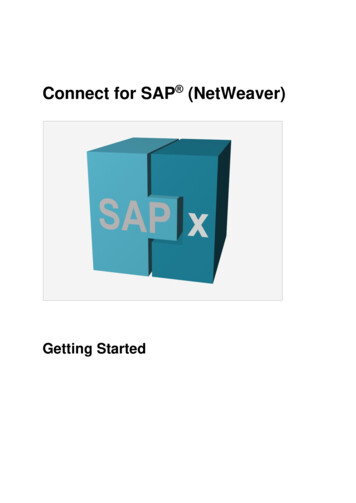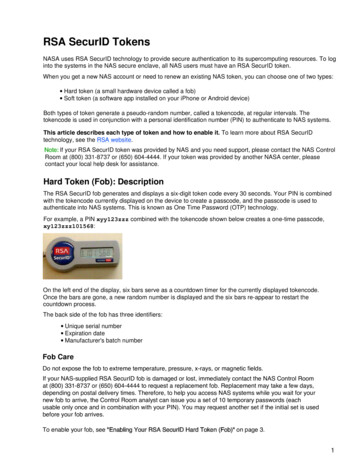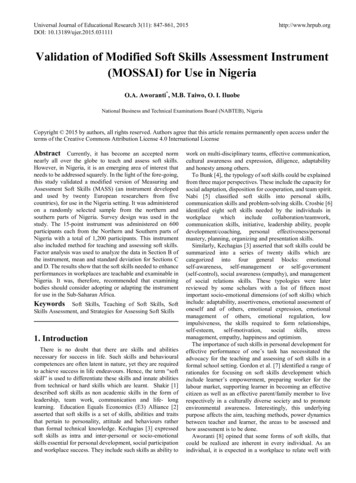
Transcription
Connect for SAP (NetWeaver)Getting Started
1About this Document .32About Connect for SAP (NetWeaver) .43Architectural overview .53.1RFC Function Architecture .63.1.1Data Representation . 63.1.2Data Mapping . 73.1.3Early and Late Function Binding . 93.23.2.1Using Connection Aliases. 123.2.2Features for Transactional Calls. 123.345Server Applications . 133.3.1Specifying Registration Parameters. 143.3.2Features for Transactional Calls. 14Installation . 154.1System Requirements . 154.2Installing RFC Library Using SAPGUI . 154.3Manual Installation of RFC Library Binaries . 174.4Requirements for SAP Server. 194.5Installing into Embarcadero Delphi or C Builder. 204.5.1Building Connect for SAP Binaries. 204.5.2Installing Components . 20Connectivity to SAP . 215.1Client Connection . 215.1.1Connection Alias . 215.1.2Connection Parameters Priority . 215.26Client Applications . 11Server Connection . 21Connect for SAP Explorer . 226.1Creating and Maintaining Connection Aliases . 226.1.1Creating or Opening a Connection Alias File . 226.1.2Creating a New Connection Alias . 226.1.3Modifying a Connection Alias . 236.2Browsing SAP Dictionary Information of RFC Functions. 256.2.1Displaying RFC Functions . 256.2.2RFC Objects Definition Information. 266.36.4Executing RFC Functions. 27Generating Wrapping Code for RFC Function . 276.4.1Generating Wrapping Code. 286.4.2How to Use Generated Code . 297Migrate Code to New Connect for SAP . 308Troubleshooting. 328.1Issue Report . 328.2Tracing . 328.2.1SAP RFC Library Tracing . 328.2.2“Connect for SAP” Tracing . 32Appendix A.Using sapnwrfc.ini . 33Appendix B.Transaction Management in Connect for SAP Server Application . 34Appendix C.Connect for SAP Component List . 35Appendix D.Changes of Connect for SAP API between 3.x and 4.x . 36Appendix E.Changes of Applications to be Applied Manually. 41Connect for SAP (NetWeaver) – Getting Startedpage 2
1About this DocumentThis document might be especially useful for Embarcadero Delphi developers in: Building applications that are SAP system clients Extending functionality of a SAP application server by creating external non-SAP server programsYou can find in this guide a general overview of the Connect for SAP software and its possible applications.This document helps to understand main architectural concepts of the Connect for SAP work: informationon the RFC function architecture, different types of the data mapping and the function binding. You will alsolearn general concepts of creating client and server applications based on Connect for SAP . The guideprovides the developer with necessary installation instructions and gives a brief overview of componentsinstalled.If you need to get any additional information not mentioned in this guide do not hesitate to contact us:Web: r-sap-sapxBy email: sapx@gs-soft.comConnect for SAP (NetWeaver) – Getting Startedpage 3
About Connect for SAP (NetWeaver)2Connect for SAP is an object-oriented software library. It has been specially designed for an access to SAPapplication servers using Embarcadero Delphi and C Builder for building partner server programs runin non-SAP systems. Connect for SAP is a flexible and versatile tool for: An integration of existing Delphi applications with SAP systems. This feature allows corporations touse their own information systems and create superstructures with additional opportunities A development of new systems and applications that have access to a SAP application server asclients An extension of SAP system functionality through Connect for SAP by building external non-SAPservers. This feature gives the developer an opportunity to avoid costs connected with the ABAPtraining as all the functionality extensions are implemented in Delphi programsConnect for SAP encapsulates a Remote Function Call (RFC) interface and offers high-level softwarecomponents and classes.RFC API is a set of C-language routines that perform certain end user’s communication tasks and allow anexecution of remote calls between two SAP Systems or between a SAP System and a non-SAP system.RFC API supports several external systems, such as OS/2, Windows, as well as all of R/3-based UNIXplatforms. This feature makes it possible to use the RFC functionality for an interaction of a SAP System witha C-program based on the platforms mentioned above (there exists an RFC SDK that includes an RFClibrary specific for each platform supported).Connect for SAP (NetWeaver) – Getting Startedpage 4
3Architectural overviewOn Figure 1 you can see the way Delphi applications can interact with a SAP system through Connect forSAP . Connect for SAP can be used both in client and server applications.In the first case, when you need to call an ABAP function you should use the Connect for SAP objectmethods and properties. Connect for SAP packs all the necessary data and transfers the call to the RFClibrary. In such a way the client request is sent to the SAP system. On receiving the request, the SAPapplication server processes it and returns the result. Connect for SAP gets the resulting data from the RFClibrary and the developer can have the access to it.SAP Application ServerRFC Functions(SE37)Client ApplicationSAP RFCSDKConnect for SAP ABAP callingexternalfunctions (SM58)SAP Gateway / RouterClientSAP NetWeaver RFCRegistered FunctionsSAP R3 systemServer ApplicationConnect for SAP ServerFigure 1: Interaction of a SAP system with Delphi application based on Connect for SAP In the second case the Connect for SAP server application is constantly waiting for the SAP system clientrequest. When the request is occurred Connect for SAP receives and processes it. Connect for SAP alsoundertakes to send the result to the SAP system in the correct format.Connect for SAP (NetWeaver) – Getting Startedpage 5
3.1RFC Function ArchitectureIf you want to understand the way an RFC function can be called and how to work with the functionparameters, it is necessary to examine RFC function architecture.Delphi data typesConnect for SAP RFC data typesRFC rametersTablesInput dataOutput dataAs it is shown on the figure above, RFC function receives data from Export parameters; Importparameters contain resulting data; whereas Tables and Changing parameters can contain both input andoutput data. Data imported from and exported to RFC function has data formats and types which differ fromDelphi ones. That is why one of the Connect for SAP most important tasks is to map RFC data types toDelphi ones and backwards.3.1.1Data RepresentationSAP R/3 servers can run on different types of computers. And they may have different than on WinTelrepresentations of integer and float data. The data representation should be changed, when the data arereceived from / transmitted to a SAP R/3 server and data representations of the server and the client aredifferent. Connect for SAP performs that for you.How Connect for SAP will do that is controlled by the alias parametersTSAPxNWAliasGS.DataFormat.IntType and TSAPxNWAliasGS.DataFormat.FloatType. By default,they have the values itAutoDetect and ftAutoDetect.The alias parameter TSAPxNWAliasGS.DataFormat.BytesPerChar specifies the server side characterdata representation – bytes per char. By default, it has the value bcAutoDetect.Connect for SAP (NetWeaver) – Getting Startedpage 6
Using the default values, Connect for SAP will automatically detect the server-side data representation. Insome special cases, you can decide to force Connect for SAP to expect some specified datarepresentation. It is not recommended, although.3.1.2Data MappingRFC data types can be divided into three groups with different mapping methods: simple data type,structured data type and tables.3.1.2.1Simple Data TypesFigure 2 shows concepts of a simple RFC data type mapping. If a data type has an ambiguous mapping, thedeveloper can indicate the target Delphi data type. Otherwise, Connect for SAP maps this data type to themost appropriate Delphi data type.dtCharGSStringdtNumGSUInt64 dtTimeGSTDateTimedtDateGSDelphi data typesSimple RFC data typesFigure 2: Simple RFC data type mappingThe next table shows the supported mapping of simple RFC data types to Delphi data and field types:RFCcodeRFCTYPERFC data typeDelphi data typeDelphi field typeCRFCTYPE CHARdtCharGSUnicodeStringftWideStringNRFCTYPE NUMdtNumGSUInt64ftSmallInt (size 4)ftInteger (size 9)ftLargeInt (size 9)XRFCTYPE BYTEdtByteGSRawByteStringftVarBytesPRFCTYPE BCDdtBCDGSTBcdftFloatIRFCTYPE INTdtIntGSIntegerftIntegerbRFCTYPE INT2dtInt1GSShortIntftSmallIntsRFCTYPE INT1dtInt2GSSmallIntftSmallIntFRFCTYPE FLOATdtFloatGSDoubleftFloatDRFCTYPE DATEdtDateGSTDateTimeftDateTRFCTYPE TIMEdtTimeGSTDateTimeftTimegRFCTYPE STRINGdtStringGSUnicodeStringftWideStringyRFCTYPE XSTRINGdtXStringGSRawByteStringftVarBytesConnect for SAP (NetWeaver) – Getting Startedpage 7
3.1.2.2Structured Data TypesUnlike a simple data type, structured one, does not have Delphi analogues. Figure 3 illustrates how theConnect for SAP wraps the dtStructureGS type by means of the TSAPxNWParameterGS class, whichcontains a field list of the TSAPxNWFieldCollectionGS class. So, the structure corresponds to the field list,where an individual field of the TSAPxNWFieldGS class represents each structure item.Connect for SAP does not support nested structured data types. It means that each structure item shouldbe of a simple data type.Field listItem 1Field 1Item 2Field 2 Item NField NStructured RFC data typeParameterFigure 3: Wrapping structured RFC data type by Connect for SAP Connect for SAP includes the TSAPxNWClientCompParametersGS component derived from theTDataSet that, on the one hand, offers a clear and easy interface for Delphi developers and, on the otherhand, works with the RFC library using the RFC data types and formats.TSAPxNWClientCompParametersGS represents each function simple parameter by a single field, andeach structured parameter by one top level field with subfields. You can choose which parameter types(input, output, changing) TSAPxNWClientCompParametersGS includes by specifying ParameterTypes.The next table shows all structured types and how to work with them in Delphi code:RFCcodeRFCTYPERFC data typeuRFCTYPE STRUCTUREdtStructureGSDelphi data typeTSAPxNWParameterGS1 1TSAPxNWFieldCollectionGS1 NTSAPxNWFieldGShRFCTYPE TABLEdtLineTypeGSNot supportedNote: Connect for SAP supports only the flat structured type RFCTYPE STRUCTURE.The data types that have a non-flat structure (deep structured tables, Line type) are notsupported. An error occurs when such a parameter is encountered.Connect for SAP (NetWeaver) – Getting Startedpage 8
3.1.2.3RFC Table ParametersWe should also pay more attention to the way Connect for SAP works with function tables featuring theirown format. SAP RFC table parameter is like a structured parameter – it has a field list but may containmultiple rows of data.Connect for SAP includes the TSAPxNWClientCompTableGS component derived from the TDataSetthat, on the one hand, offers a clear and easy interface for Delphi developers and, on the other hand, workswith the RFC library using the RFC data types and formats. TSAPxNWClientCompTableGS correspondsto one table parameter with TableName name.The next table shows converting RFC table parameters to Delphi data type:RFC data typeDelphi data typeDelphi componentRFC table .2.4Unicode Character DataConnect for SAP supports Unicode. This means, that for the CHAR data type and for the object names,the library always uses the Unicode UCS-2 encoded character data.3.1.3Early and Late Function BindingThere are two types of binding ABAP RFC functions with Connect for SAP function objects in Connect forSAP , early and late binding.The early binding means that an ABAP function name has been known at design time already. So, theConnect for SAP function object is statically defined. It is recommended to use the Connect for SAP Explorer tool to generate a wrapping code for the ABAP functions. That will save you a lot of time and willhelp you to avoid lots of mistakes. See Generating Wrapping Code for RFC Function for details andrestrictions applied to the code generation. The next listing shows an example of the generated wrappingcode:Listing 1: Early binding. Wrapping code generated for RFC READ TABLE ABAPfunction by Connect for SAP Explorer.TSAPxNWRFC READ TABLEFuncGS class(TSAPxNWClientFunctionGS)privateprocedure SetDELIMITER(const AValue: String);function GetDELIMITER: String;function GetDATA: TSAPxNWTAB512TableGS;publicconstructor Create; override;property DELIMITER: String read GetDELIMITER write SetDELIMITER;property DATA: TSAPxNWTAB512TableGS read GetDATA;end;Connect for SAP (NetWeaver) – Getting Startedpage 9
On the contrary, the late binding allows the developer to call an ABAP function at runtime dynamically. In thiscase Connect for SAP automatically gets the necessary metadata. The next listing shows an example of thelate binding:Listing 2:Late binding. Using a dynamically prepared function.procedure Execute;begin// working with TSAPxNWClientFunctionGS object interfacewith FCFunction do beginObjName : ‘RFC READ TABLE’;Prepared : pter.AsString : ‘%’;ExecFunction;with Tables.ItemByName('DATA') do begin{ do something with table ‘DATA’ }end;end;end;The main differences between the early and the late binding: The early binding has a higher productivity as it excludes application round trip to the SAP system formetadata retrieval The early binding allows to use the Code Insight feature and find some mistakes during compileprocess The late binding has smaller performance but wider flexibilityThe developer can choose a binding mode depending on a specific task.Hint: early binding can improve the execution speed significantly for methods sequentiallycalled many times per second.Note: The first preparation of a client function’s call requires a lookup in back-end system’sdata dictionary (DDIC). In case the function module has many parameters or tables it may takeup to several seconds. After that, further calls will use data cached by the RFC library locally.For additional details see description of NetWeaver API function RfcGetFunctionDesc).So, it is recommended an explicit preparation (TSAPxNWClientFunctionGS.Prepare) of thecalling function before the first execution (for example, in a background thread).Connect for SAP (NetWeaver) – Getting Startedpage 10
3.2Client ApplicationsThe next figure illustrates the architecture of a client application build with the Connect for SAP componentsusing Embarcadero mpTableGSConnect for SAP TDataSourceTDataSourceTDataSourceDelphi client applicationThe TSAPxNWClientCompConnectionGS component is responsible for connection to SAP server. Usethe Params property to specify connection parameters on the fly or the AliasName property to use apredefined connection alias. Set Connected to True to establish the connection. Such components asTSAPxNWClientCompFunctionGS and TSAPxNWClientCompServerTableGS use theTSAPxNWClientCompConnectionGS object to communicate with the RFC library.The main Connect for SAP client component is TSAPxNWClientCompFunctionGS . It is responsible fordescribing and executing of SAP functions using the SAP RFC library. Set the Connection property to aconnection component. Use the ObjName property to specify a function name to call. The OutParametersproperty represents an output parameter collection, the InParameters – collection of input parameters, theVarParameters – collection of parameters used for input and output, the Tables – collection of tables.These properties are not accessible at design time.The developer can use the TSAPxNWClientCompParametersGS and TSAPxNWClientCompTableGScomponents to operate with parameters and tables of TSAPxNWClientCompFunctionGS. Set the Funcproperty to a function component. Use TSAPxNWClientCompParametersGS.ParameterTypes tospecify parameter types (input, output, changing) to represent. UseTSAPxNWClientCompTableGS.TableName to specify table parameter to represent.The components TSAPxNWClientCompParametersGS , TSAPxNWClientCompTableGS , andTSAPxNWClientCompServerTableGS inherited from TDataSet can be linked with any data awarecontrols.To build a client application you can use components as well as objects encapsulated into thesecomponents, e.g. the RFCFunction property of TSAPxNWClientCompFunctionGS.Connect for SAP (NetWeaver) – Getting Startedpage 11
3.2.1Using Connection AliasesA client application establishes a communication with a SAP system through the SAP RFC library. Theconnection is defined by a set of parameters, which has to be specified before connecting.For convenience developers may use Connect for SAP aliases to define the connection parameters. Analias is a named stored set of the parameters. By default, the aliases are stored in the%Windows%\SAPxNWAliases.ini file.The Connect for SAP Explorer tool is used to maintain the aliases and test them (see Connectivity to SAPfor details).3.2.2Features for Transactional CallsConnect for SAP supports transactional functions. The transactional function should be called only betweenstarting and ending points of a transaction. These are distinctive features of transactional calls: CallType property of TSAPxNWClientCompFunctionGS should be set to ftTransactionalGS. TSAPxNWClientCompFunctionGS should have no import parameters. Only one function can be called within a singular transaction.Connect for SAP (NetWeaver) – Getting Startedpage 12
3.3Server ApplicationsThe next figure illustrates the architecture of a server application build with the Connect for SAP components using Embarcadero Delphi.RFC pConnectionGS1nTSAPxNWServerCompFunctionGSConnect for SAP Delphi server applicationThe TSAPxNWServerCompConnectionGS component is responsible for a registration of a server on agateway and a communication of the TSAPxNWServerCompFunctionGS components with a SAP systemthrough the SAP RFC library. Use the CommandLine property to specify registration parameters. SetConnected to True to establish the registration. All requests to the functions registered with this connectionare serialized and handled in a single thread.The main Connect for SAP server component is TSAPxNWServerCompFunctionGS. It is responsible forinstalling description and execution of requests to a custom RFC function using the SAP RFC library. Set theConnection property to a server connection component. Use the ObjName property to specify the functionregistration name. Create an OnExecute handler, which will handle the custom function request. TheOutParameters property represents an output parameter collection, the InParameters – collection of inputparameters, the VarParameters – collection of parameters used for input and output, the Tables –collection of tables. These properties are not accessible at design time.Note: When you construct a table or a parameter of structure type for Server Function, it isrecommended to explicitly define the property StructName. This allows obtaining of therequired metadata from the SAP system the function will be connected to. In case the propertyhas not been defined the metadata will be created locally based on defined fields. That is lesssafe due to possible mismatches between fields defined on SAP system and ones added to thefunction locally.And the SAPxNWServerApplication is a singleton, controlling the Connect for SAP server application lifecycle. All the TSAPxNWServerCompConnectionGS and TSAPxNWServerCompFunctionGS objectsmust be created and setup before calling SAPxNWServerApplication.Start. The method creates a threadfor each server connection. Then each thread registers its server connection at the gateway, installs atransaction control and installs all associated with this connection custom functions. Now the Connect forSAP server application is able to handle requests from external SAP systems.Connect for SAP (NetWeaver) – Getting Startedpage 13
The SAPxNWServerApplication.Shutdown method stops the Connect for SAP server application.Server applications as well as client ones can be built on both Connect for SAP components and objectsencapsulated into these components.3.3.1Specifying Registration ParametersThe server connection parameters can be specified in the command line when the server application isstarting. In this case the command line parameters are automatically assigned to the CommandLineproperty of the TSAPxNWServerCompConnectionGS component. Appendix A shows the command lineswitches and their meaning. When the server starts it becomes possible to specify either PROGRAM ID,GWHOST, GWSERV and RFC TRACE parameters or just a DESTINATION parameter solely.In the second case, you need to define the entry named DESTINATION in the saprfc.ini file specifyingall connection parameters (see example in Appendix A). This way to specify the server connectionparameters is much more flexible than the first one.While using the command line it is very important to remember that you cannot specify more than one set ofthe server connection parameters. So, for server applications with multiple connections the developer shouldexplicitly specify the CommandLine property of the TSAPxNWServerCompConnectionGS component.3.3.2Features for Transactional CallsConnect for SAP supports transactional server functions. You can use the transactional RFC to bundleseveral remote functions into one logical unit of work (LUW) (with an automatic rollback mechanism in caseof error). With the transactional RFC, generated LUW’s are processed independently of each other. Thismeans, the order in which they are processed is not always the order in which they are generated. Check theSAP help page for more details.Connect for SAP (NetWeaver) – Getting Startedpage 14
44.1InstallationSystem RequirementsBefore installing Connect for SAP ensure that Embarcadero Delphi XE6 or higher is installed on your PC.4.2Installing RFC Library Using SAPGUIConnect for SAP uses SAP NetWeaver RFC library internally. The recommended way to install therequired RFC DLLs is to install the add-on “Business Explorer” distributed by SAP along with SAPGUI.The main steps of the installation are shown below:1. Start the SAPGUI installer.Connect for SAP (NetWeaver) – Getting Startedpage 15
2. Select (at least) the following components.3. After installation, all files required for NetWeaver RFC are added to the system.Note: Use SAPGUI of version 7.70 and higher for the automatic installation of NetWeaver RFCDLLs.In case, you have already installed Classic RFC DLLs, NetWeaver RFC DLLs will be installed bySAPGUI 7.70 in parallel.Connect for SAP (NetWeaver) – Getting Startedpage 16
The exact version of your SAPGUI installation can be found by using the “About” window of SAPLogon.4.3Manual Installation of RFC Library BinariesThe process of the RFC library installation is described in details wnload and Installation of NW RFC SDK.Hint: To install NetWeaver RFC for x64 environment use the manual installation described inthis topic.In general, you will need to copy the few SAP RFC runtime DLL’s to the system folder (see Table 1 fordetails). Also, it may be required to install the Microsoft VC Ru
Connect for SAP (NetWeaver) – Getting Started page 5 3 Architectural overview On Figure 1 you can see the way Delphi applications can interact with a SAP system through Connect for SAP .Connect for SAP can be used both in client and server applications. In the first case, when the developer wants to call an ABAP fun











